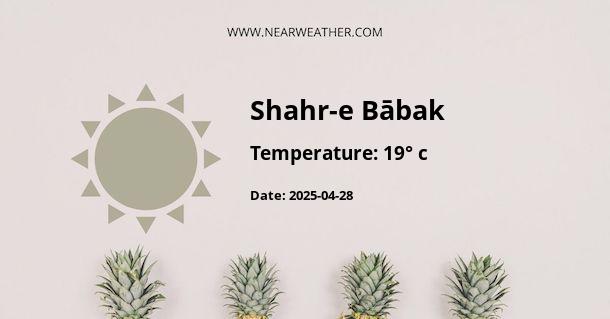Climate and Weather in Shahr-e Babak, Iran
Shahr-e Babak is an ancient city situated in the province of Kerman, Iran. The city, rich in history and culture, is also known for its unique climate and weather patterns. This article explores the climatic conditions and weather trends that characterize Shahr-e Babak throughout the year.
Overview of Shahr-e Babak's Climate
Shahr-e Babak's climate is classified as a cold desert climate. The classification under the Köppen-Geiger system is BWk, denoting a desert climate with cold winters. This means that the city experiences high temperature variations between day and night as well as between seasons.
Temperature Variations
In Shahr-e Babak, the average annual temperature is approximately 15.6 °C. The warmest month, on average, is July with an average temperature of 26.1 °C. The coolest month on average is January, with an average temperature of 4.9 °C.
| Month | Average Temperature (°C) |
|---|---|
| January | 4.9 |
| July | 26.1 |
Precipitation Levels
Despite being categorized as a desert climate, Shahr-e Babak does receive some rainfall throughout the year. The precipitation here averages 210 mm annually. The month with the most rainfall on average is January, with an average of 46 mm. The month with the least rainfall on average is June, with an average of 1 mm.
| Month | Average Rainfall (mm) |
|---|---|
| January | 46 |
| June | 1 |
Humidity and Wind
Relative humidity in Shahr-e Babak varies throughout the year. On average, the most humid month is January, while the least humid month is June. The wind in Shahr-e Babak is usually calm. The windiest month is June, followed by May and July.
"Shahr-e Babak's weather is a mix of extremes: from its cold winters to its hot summers, and from its dry desert conditions to its occasional rainfall."
Year-round Weather in Shahr-e Babak
Understanding the climate of Shahr-e Babak is essential for planning visits and understanding the best time to visit this historical city. Here's a month-by-month breakdown of the weather:
- January: Coldest month, highest rainfall.
- February: Slightly warmer, less rainfall.
- March: Warmer temperatures, rainfall decreases.
- April: Spring begins, temperatures rise, rainfall decreases.
- May: Warm temperatures, low rainfall.
- June: Hottest month, lowest rainfall, highest wind speed.
- July: Very hot, low rainfall.
- August: End of summer, temperatures begin to decrease.
- September: Autumn begins, temperatures continue to fall.
- October: Cooler temperatures, rainfall begins to increase.
- November: Rainfall continues to increase, temperatures continue to fall.
- December: Approach of winter, temperatures continue to drop, rainfall increases.
Conclusion
Shahr-e Babak offers a unique mix of weather conditions, from desert heat to winter chills, from windy summers to rainy winters. It's a city of contrasts, not just in terms of its rich history and culture, but also in its climate and weather. Whether you're planning a visit or simply curious about the city's climate, understanding the weather patterns of Shahr-e Babak can provide a fascinating insight into life in this ancient city.
A - Shahr-e Bābak's Latitude is 30.116501 & Longitude is 55.118599.
A - Weather in Shahr-e Bābak is 17° today.
A - Climate Conditions in Shahr-e Bābak shows clear sky today.
A - Humidity in Shahr-e Bābak is 17% today.
A - Wind speed in Shahr-e Bābak is 21.49 km/h, flowing at 59° wind direction. today.
